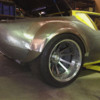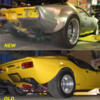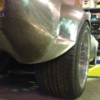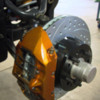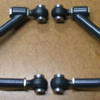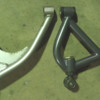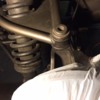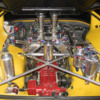Just like to tell. Just get crazy and order new rims for widebody build in 20x12 and 20x15 with 5inch backspacing.
Kjeld
quote:Excellent point. My aftermarket rims don't have that extra lip. So instead of an extra 1/2 on each side like the drawing, mine have approximately 1/4 extra on each side. So my 9 inch rims measure 9.5 inches from the outside to the outside portion of the rim. They measure 9 inches where the tire seats.
My rear 12 inch rims measure 12.5 from the outside lip to the outside lip.
This is exactly why most high-end wheel manufacturers nearly always refer to offset as opposed to backspacing. With offset, the thickness of the outer "lip" doesn't effect the measurement. You would typically only have a half-inch thick outer lip with a cast alloy wheel.
Great job Tony. Where are you in Australia? I am planning a trip over and this yank would like to meet as many down under Pantera owners as possible.
My front rims are centre offset.
I take the measurements from the important part of the rim, the bead area.
What is outside of the bead face is of no consequence & varies greatly between pressed steel, cast alloy or spun rims.
Kirk, I’m in Perth Western Australia.
Yes it would be great to catch up.
Regards,
Tony.
I take the measurements from the important part of the rim, the bead area.
What is outside of the bead face is of no consequence & varies greatly between pressed steel, cast alloy or spun rims.
Kirk, I’m in Perth Western Australia.
Yes it would be great to catch up.
Regards,
Tony.
To David's point, if we don't use a consistent way to measure the offset or backspace, the data is useless or misleading. Offset may be a better number since the lip type doesn't matter...
Thanks for all the info, I wasn't sure how to measure rim width and offset/backspace until this topic came up.
Thanks for all the info, I wasn't sure how to measure rim width and offset/backspace until this topic came up.
Looking good Tony. Good to have you back and please keep us up to date with plenty of pictures.
Best,
K
Best,
K
Tony, what is your process for smoothing the seam between fender and car body after welding?
An angled die grinder with various types of small sanding pads.
regards,
Tony.
regards,
Tony.
Larry.
So that extra plate that can be seen in my original arm is not "original" & possibly modified?
With my huge 345/35-19 tyres I needed to lower the car alot to get the stance right.
So I made my new top arms a little longer to dial out some of the excessive negative camber & included the adjustment for fine tuning.
regards,
Tony.
So that extra plate that can be seen in my original arm is not "original" & possibly modified?
With my huge 345/35-19 tyres I needed to lower the car alot to get the stance right.
So I made my new top arms a little longer to dial out some of the excessive negative camber & included the adjustment for fine tuning.
regards,
Tony.
Really beautiful workmanship and engineering Tony.
The control arms are works of art.
The control arms are works of art.
Tony, most Panteras' upper rear subframes tend to spread and distort over time, developing excess negative camber. Huge, sticky rear tires tend to make this situation worse, even cracking paint on the rear fenders. The stock bay brace is almost useless in preventing all this since, along with the upper front ball joint mounts, one simply cannot tighten the bolts tight enough to prevent bumps from making the bolts move.
With a good aftermarket (or home-made) adjustable upper bay brace, the rear chassis can be preloaded enough, slowly over time, to tease the rear subframes back into stock alignment. This makes longer upper rear a-arms redundent, although most I've seen appear stronger than stock. And at least they're better than some early efforts to 'correct' excess rear camber by lathe-cutting the lower a-arm clevis-ends so the lower a-arms were pulled inward more.... while weakening the attach points to the frame.
With a good aftermarket (or home-made) adjustable upper bay brace, the rear chassis can be preloaded enough, slowly over time, to tease the rear subframes back into stock alignment. This makes longer upper rear a-arms redundent, although most I've seen appear stronger than stock. And at least they're better than some early efforts to 'correct' excess rear camber by lathe-cutting the lower a-arm clevis-ends so the lower a-arms were pulled inward more.... while weakening the attach points to the frame.
Good points Bosswrench.
I love hearing the history of Pantera issues, cures & modifications.
My negative camber issue is the top arm going past horizontal.
This is due to lowering the car so much due to the large wheel diameter.
As the car lowers the top arm arcs inward & progressively throws the rear into negative camber.
Here is a picture of my engine bay brace.
The rear attachments connect to the old bumper mounts.
Although I’m going to have to gut out the engine bay for the new engine, which gives me the opportunity to reinforce these areas & add bar work as required.
Regards,
Tony.
I love hearing the history of Pantera issues, cures & modifications.
My negative camber issue is the top arm going past horizontal.
This is due to lowering the car so much due to the large wheel diameter.
As the car lowers the top arm arcs inward & progressively throws the rear into negative camber.
Here is a picture of my engine bay brace.
The rear attachments connect to the old bumper mounts.
Although I’m going to have to gut out the engine bay for the new engine, which gives me the opportunity to reinforce these areas & add bar work as required.
Regards,
Tony.
Attachments
Add Reply
Sign In To Reply


